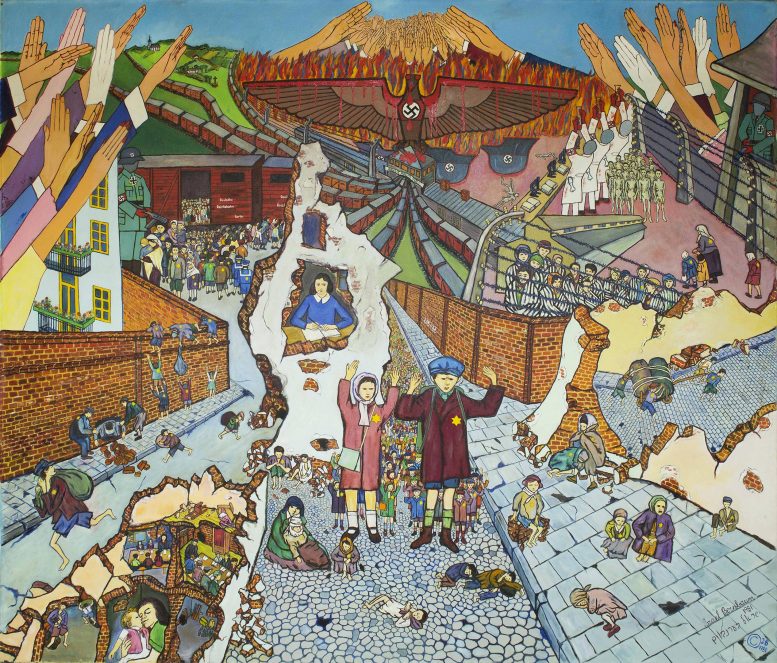
Painting by Israel Bernbaum, 1981. Oil on canvas, 70 3/8 x 82 1/4 inches. Credit: Property of the Montclair State University Permanent Collection, MSU 2011.003.002, Montclair State University, 1 Normal Avenue, Montclair, New Jersey 07043 USA
New modeling of Typhus infections in the Warsaw Ghetto during WWII reveals how public health interventions eradicated the disease.
Through state-of-the-art mathematical modeling and historical documents, the study points to community health programs and social distancing practices as the most likely explanations for the epidemic’s sudden and mysterious collapse, which was hailed by survivors at the time as a miracle.
The historical analysis underscores the critical importance of the cooperation and active recruitment of communities in efforts to defeat epidemics and pandemics such as COVID-19, rather than relying too heavily on government regulation.
Mathematician and disease modeler Professor Lewi Stone from RMIT University and Tel Aviv University led the study published in Science Advances, with collaborators from Hong Kong, Amsterdam, and Berlin.
In 1941, the Nazi forces in Poland crammed more than 450,000 inmates into a confined 3.4 km² (1.2 mi²) area known as the Warsaw Ghetto.
“With poor conditions, rampant starvation, and a population density 5 to 10 times higher than any city in the world today, the Warsaw Ghetto presented the perfect breeding ground for bacteria to spread Typhus and it ripped through the mainly Jewish population there like a wild fire. Of course, the Nazis were well aware this would happen,” Stone says.
As many as 120,000 ghetto inmates were infected by Typhus, with up to 30,000 dying directly from it and many more from starvation or a combination of both.
Stone says it was a historically documented case of disease being used as a weapon of war and as a pretext for genocide.
“Then, in October 1941, as a harsh winter was beginning and just as Typhus rates would be expected to skyrocket, the epidemic curve suddenly and unexpectedly nose-dived to extinction,” he says.
“It was inexplicable at the time and many thought it was a miracle or irrational.”
The team’s mathematical modeling designed with theoretical ecologist Dr. Yael Artzy-Randrup (University of Amsterdam) together with modeling and statistical analysis carried out by Dr. Daihai He (Hong Kong Polytechnic University), shows the epidemic was in fact on track to become 2 to 3 times larger and peak in the middle of winter, just before it disappeared.
So, what happened?
How the Ghetto beat Typhus
Stone says the steady decline in disease transmission rates most likely reflects the success of behavioral interventions.
“Fortunately, many of the anti-epidemic activities and interventions are documented and it turns out that Warsaw Ghetto had many experienced doctors and specialists,” he says.
“To learn more, I spent many, many hours in libraries around the world seeking rare documents or publications to find details about the interventions employed and the actual size of the epidemic itself, which was also poorly recorded.”
Stone found evidence of well-organized training courses covering public hygiene and infectious diseases, hundreds of public lectures on the fight against Typhus, and an underground medical university for young students.
General hygiene and apartment cleanliness were encouraged and sometimes enforced. Social distancing was considered basic common sense, and home quarantining was not uncommon. Many volunteer soup kitchens were opened up in the period before the epidemic’s decline.
“In the end, it appears that the prolonged determined efforts of the ghetto doctors and anti-epidemic efforts of community workers paid off,” Stone says.
“There is no other way we can find to explain the data.”
Holocaust historian Stephan Lenstaedt from Touro College in Berlin assessed the team’s modeling in relation to archival material.
It tallied with primary sources including respected historian, Israel Gutman, who wrote “while almost 100,000 ghetto residents died mostly from starvation and disease in the period up until July 1942, a similar or greater number were saved thanks to the dedicated relief workers and self-help relief agencies operating”.
“The tragedy, of course,” says Stone, “is that almost all of those lives saved through these sacrifices, discipline, and community programs would soon end in extermination at the Nazi death camps.”
Typhus — a bacterial disease spread by lice — had pandemic status in Europe. It is less contagious but deadlier than COVID-19. While the two diseases spread and behave differently, the team says there are still parallels and lessons to be learned.
“Today, more than ever, society needs to grasp how the damage caused by a tiny virus or bacteria can create utter havoc, dragging humankind to the terminal point of evil as witnessed over the Holocaust,” Stone says.
“As those in the Warsaw Ghetto demonstrated, however,” Artzy-Randrup explains, “the actions of individuals in practicing hygiene, social distancing, and self-isolating when sick, can make a huge difference within the community to reduce the spread.”
“It is the cooperation and active recruitment of communities that beat epidemics and pandemics, not government regulations alone.”
“Only recently have we witnessed at close view how essential community engagement has been in containing and defeating the deadly and horrifying spread of Ebola outbreaks across African countries.”
“This study is a unique instance where quantitative and qualitative methods could be used for revealing hidden historical processes at the interface of infectious diseases and society, that are directly relevant to the present COVID-19 crisis.”
“Unquestionably, there are invaluable lessons for us to learn from the past,” says Lehnstaedt.
Reference: “Extraordinary curtailment of massive typhus epidemic in the Warsaw Ghetto” by Lewi Stone, Daihai He, Stephan Lehnstaedt and Yael Artzy-Randrup, 24 July 2020, Science Advances.
DOI: 10.1126/sciadv.abc0927









Be the first to comment on "“Miracle” of How the Warsaw Ghetto Beat the Infectious Disease Typhus Finally Revealed"